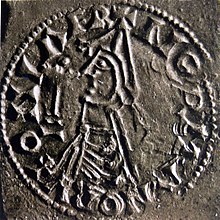
Back Anlaf II Norrena Cyning ANG أولاف الثاني Arabic اولاف التانى ARZ ایکینجی اولاف (نوروژ) AZB Олаф II Святы Byelorussian Олаф II Bulgarian Olaf II, kralj Norveške BS Olaf II de Noruega Catalan Olaf II. Norský Czech Olav den Hellige Danish
| Olaf II Haraldsson | |||||
|---|---|---|---|---|---|
 Coin of Olaf dated 1023–28 | |||||
| King of Norway | |||||
| Reign | 1015–1028 | ||||
| Predecessor | Sweyn Forkbeard | ||||
| Successor | Cnut the Great | ||||
| Born | c. 995 Ringerike, Norway | ||||
| Died | 29 July 1030 (aged around 35) Stiklestad, Norway | ||||
| Spouse | Astrid Olofsdotter of Sweden | ||||
| Issue | Wulfhild, Duchess of Saxony Magnus I of Norway (ill.) | ||||
| |||||
| House | St. Olaf | ||||
| Father | Harald Grenske | ||||
| Mother | Åsta Gudbrandsdatter | ||||
| Religion | Chalcedonian Christianity | ||||
Olaf II Haraldsson (c. 995 – 29 July 1030), also Olav Haraldsson and Olaf the Stout, later known as Saint Olaf and Olaf the Holy, was King of Norway from 1015 to 1028. Son of Harald Grenske, a petty king in Vestfold, Norway,[1] he was posthumously given the title Rex Perpetuus Norvegiae (English: Eternal/Perpetual King of Norway) and canonised at Nidaros (Trondheim) by Bishop Grimketel, one year after his death in the Battle of Stiklestad on 29 July 1030. His remains were enshrined in Nidaros Cathedral, built over his burial site. His sainthood encouraged the widespread adoption of Christianity by Scandinavia's Vikings/Norsemen.
Pope Alexander III confirmed Olaf's local canonisation in 1164, making him a recognised saint of the Catholic Church, and Olaf started to be known as Rex Perpetuus Norvegiae – eternal king of Norway. Following the Reformation, he was a commemorated historical figure among some members of the Lutheran and Anglican Communions.[2]
The saga of Olav Haraldsson and the legend of Olaf the Saint became central to a national identity. Especially during the period of romantic nationalism, Olaf was a symbol of Norwegian independence and pride. Saint Olaf is symbolised by the axe in Norway's coat of arms and Olsok (29 July) is still his day of celebration. Many Christian institutions with Scandinavian links as well as Norway's Order of St. Olav are named after him.[3]
- ^ "Harald Grenske (Family Links)". Archived from the original on 31 October 2010. Retrieved 2 June 2010.
- ^ "The Calendar". The Prayer Book Society of Canada. 16 October 2013. Archived from the original on 22 October 2019. Retrieved 12 January 2017.
- ^ Fredrik Paasche (29 July 1930). "Olav Haraldsson". Den norske kirkes 900-årsjubileum. Retrieved 1 September 2017.